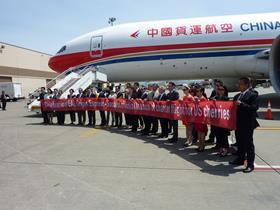
Cherry imports are 'flying' in China – that much is clear from the latest market reports underlining a surge in airfreight shipments during the US season.
According to Kurt Huang of Shanghai Oheng Import & Export Co, which specialises in customs clearance and logistics service provision in Shanghai, between 7,500 and 8,500 pallets of cherries have been airfreighted from California and the Northwest (Washington and Oregon) during the current season, marking a record year.
China Eastern Airlines, which launched a weekly charter service in June, has shipped around 1,000 pallets on seven flights, Huang estimated. But there have been plenty of shipments with other airlines, capitalising on the frequency of flights between the US and China.
“On 17 July, we handled 282 pallets in one day,' said Huang. 'There are around 30 days in the season, and we've been averaging daily arrivals of more than 100 pallets.'
While airfreighted fruit is traditionally much more expensive than seafreight product, Huang said that the price differential has narrowed because of the frequency of services and the availability of freight space.
“Actually, the airfreighted cherries are not that much more expensive than seafreighted fruit,” said Huang. “There are a lot of flights from the US and you can buy space for as little as US$1-1.5 per kg. It’s not like flying fruit from Chile.
'Also, the arrival condition has been very good with no quality issues, so that also makes it cost competitive. The cost difference between air and sea shipments is around RMB60 (US$9.75) per carton, once you factor in freight and import costs.'
While the US cherry season is now winding down, Huang said some Canadian cherries were being flown in from British Columbia, but that the volumes were small. “We expect more of the Canadian cherries to arrive by sea to target demand for the September Moon Festival.”
Reflecting on the US campaign, Huang said it had been a reasonable year for Northwest cherries. “There was a period in mid-July when the prices were not good, falling to around RMB260 (US$42) per [5kg] carton, but it was acceptable because of the big volume coming in.”
Cherry wars online
A significant percentage of the airfreight cherry shipments have been entering China’s rapidly growing but increasingly competitive e-commerce sector.
“All the online stores are using cherries to fight, and they’re competing on price, said Huang. “These online retailers buy direct from growers and sell direct to consumers, so it has some impact on the wholesale trade.”
While the rise of online channels has taken some share away from the traditional wholesale business, Huang said the biggest impact for wholesale sales this year had been the domestic cherry crop in China.
“China had a big cherry crop and the fruit was selling at really cheap prices right from May through to mid-July,” he said. “The production is growing each year, with most of it coming out of Shandong and Liaoning provinces.”






No comments yet